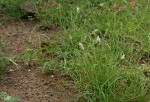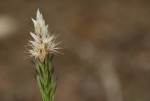| Home | > | List of families | > | Poaceae | > | Enneapogon | > | desvauxii |
Enneapogon desvauxii
Selected images: Click on each image to see a larger version and details of the record View all images (2)
Detailed records: Display species records QDS maps by: Google Maps Point records by Google Maps
Species details: Click on each item to see an explanation of that item (Note: opens a new window)
| Synonyms: |
Enneapogon brachystachyus (Jaub. & Spach) Stapf Enneapogon brachystachyus var. macranthera Stapf Enneapogon pusillus Rendle Pappophorum arabicum Hochst. ex Steud. Pappophorum brachystachyus Jaub. & Spach Pappophorum bulbosum Fig. & De Not. Pappophorum figarianum Fig. & De Not. Pappophorum nanum Steud. Pappophorum pusillum (Rendle) K. Schum. Pappophorum senegalense Steud. Pappophorum vincentianum J. A. Schmidt |
| Common names: | Eight-day grass (English) |
| Frequency: | |
| Status: | Native |
| Description: |
A compact caespitose often stoloniferous perennial, usually densely glandular-pubescent all over. Culms 5-15 (rarely to 40) cm. tall, 2-5-noded, geniculately ascending, sometimes decumbent, often with a bulbous thickening at the base, simple or branched, rather slender, asperulous. Leaves mostly confined to the base, forming dense tufts; sheaths tight at first later somewhat loose, finely to coarsely striate, the oldest long-persistent and splitting into fibres which form dense cushions at the base of the culm. Leaf-laminae 2.5-7.5(12) x 0.3-0.5 cm., filiform, almost always convolute, tapering to a very fine point, flexible, asperulous. Panicle 1.5-5(7.5) cm. long, spike-like, narrowly cylindrical or rarely ovate-oblong in outline, rather dense, light to dark grey. Spikelets 3-5.5 mm. long, 3-flowered (see note below), crowded. Glumes subequal, oblong, scantily pilose, with the apex obtuse to slightly emarginate, light to dark grey; the inferior 2.3-5 mm. long, 3-7-nerved; the superior 2.8-5.5 mm. long, 3-5-nerved. Fertile lemma (the inferior) 1.5-2 mm. long (excluding the awns), dorsally shortly villous; awns 2-4 mm. long, shortly plumose to or beyond the middle. Anthers 0.3-0.5 (rarely 0.7) mm. long. Caryopsis c. 1 mm. long. |
| Notes: | |
| Derivation of specific name: | |
| Habitat: | Growing in open grassland, in limestone pans, on grassy hillsides and stony outcrops, also on thin soil overlapping basalt rocks, often in overgrazed areas |
| Flowering time: | |
| Worldwide distribution: | south-western Africa, southern Angola, North Africa from the Cape Verde Islands to Egypt, through Arabia to India and China, in tropical Africa from Chad and Somalia southwards to the Cape Province, Botswana, Zimbabwe |
| Botswana distribution: | N,SW,SE |
| Growth form(s): | |
| Endemic status: | |
| Red data list status: | |
| Insects associated with this species: | |
| Spot characters: | Display spot characters for this species |
| Literature: |
Launert, E. (1971). Poaceae Flora Zambesiaca 10(1) Pages 145 - 147. (Includes a picture). Mapaura, A. & Timberlake, J. (eds) (2004). A checklist of Zimbabwean vascular plants Southern African Botanical Diversity Network Report No. 33 Sabonet, Pretoria and Harare Page 103. Roodt, V. (2015). Grasses & Grazers of Botswana and the surrounding savanna Struik Nature, South Africa Pages 96 - 97. (Includes a picture). Setshogo, M.P. (2005). Preliminary checklist of the plants of Botswana. Sabonet Report no. 37. Sabonet, Pretoria and Gaborone Page 136. |
Other sources of information about Enneapogon desvauxii:
Our websites:
Flora of Zimbabwe: Enneapogon desvauxiiExternal websites:
African Plants: A Photo Guide (Senckenberg): Enneapogon desvauxiiAfrican Plant Database: Enneapogon desvauxii
BHL (Biodiversity Heritage Library): Enneapogon desvauxii
EOL (Encyclopedia of Life): Enneapogon desvauxii
GBIF (Global Biodiversity Information Facility): Enneapogon desvauxii
Google: Web - Images - Scholar
iNaturalist: Enneapogon desvauxii
IPNI (International Plant Names Index): Enneapogon desvauxii
JSTOR Plant Science: Enneapogon desvauxii
Mansfeld World Database of Agricultural and Horticultural Crops: Enneapogon desvauxii
Plants of the World Online: Enneapogon desvauxii
Tropicos: Enneapogon desvauxii
Wikipedia: Enneapogon desvauxii
| Home | > | List of families | > | Poaceae | > | Enneapogon | > | desvauxii |

